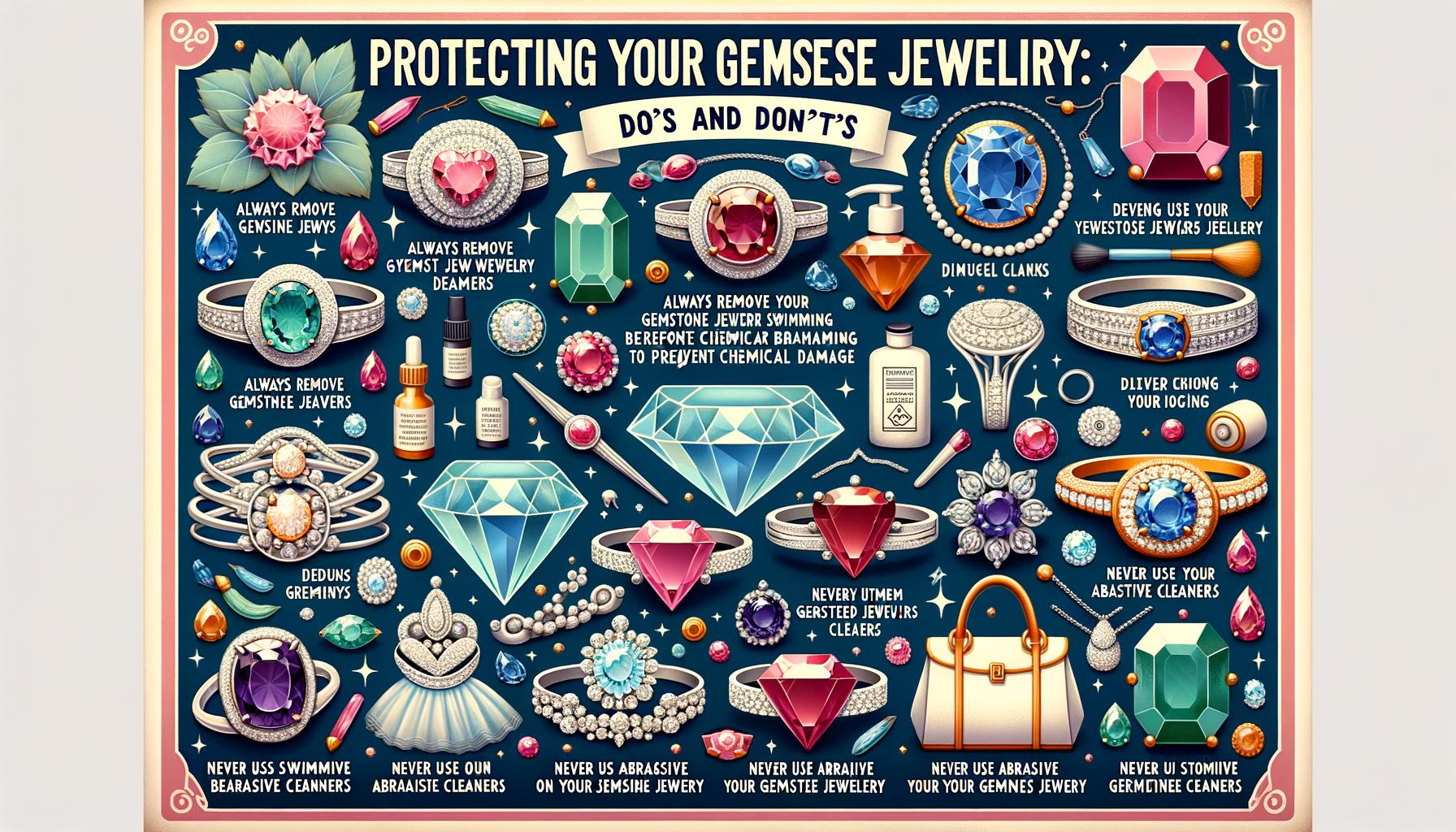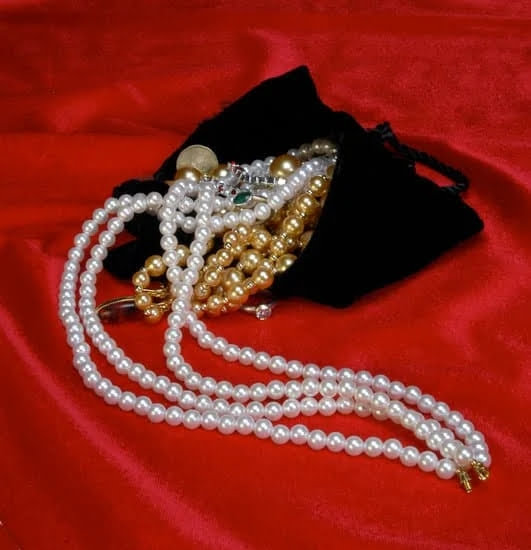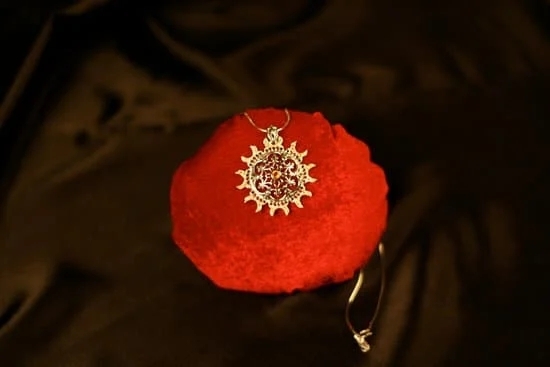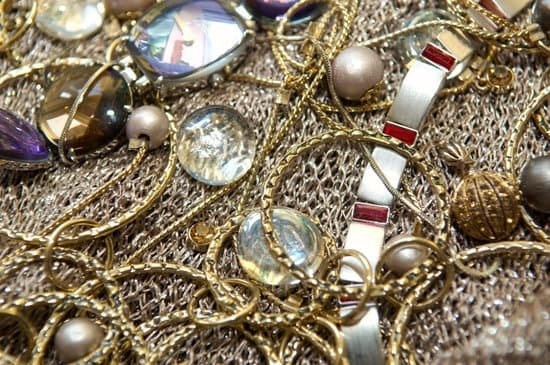Gemstone jewelry, with its dazzling allure and profound significance, deserves meticulous care to maintain its splendor. In the realm of fine jewelry, knowing the dos and don’ts of protecting your gemstone jewelry is paramount. Proper care not only preserves their radiance but also extends their longevity-crucial elements for pieces that often carry both sentimental and monetary value.
These precious adornments are more than mere accessories; they can be cherished heirlooms passed down through generations or significant investments representing key milestones in life. Whether it’s a sparkling diamond ring symbolizing an engagement or a vivid sapphire necklace marking a personal achievement, each piece tells a story. Ignoring proper gemstone care can lead to unnecessary damage, ultimately diminishing not just the appearance but also the intrinsic worth of these pieces.
Understanding how to nurture these gemstones goes beyond simple cleaning; it involves knowing their unique characteristics and requirements. The investment in learning proper maintenance routines will pay off, ensuring that your gemstone jewelry continues to shine bright and remain intact through daily wear, special occasions, and everything in between. Let’s delve into the importance of gemstone care and outline what you should-and shouldn’t-do to protect these prized possessions effectively.
Understanding Your Gemstone
Gemstone jewelry comes in a dazzling array of types and characteristics, each bringing its own unique appeal and care requirements. Understanding these nuances is essential for protecting your gemstone jewelry: dos and don’ts. From diamonds with the highest hardness rating to more delicate stones like opals, recognizing what makes them special can help you customize your care routine.
Common types of gemstones include diamonds, sapphires, emeralds, rubies, amethysts, opals, and many more. Diamonds are renowned for their unmatched hardness-rated 10 on the Mohs scale-which makes them particularly durable for everyday wear.
Sapphires and rubies also score high on the scale (9), making them resilient but still requiring thoughtful handling to maintain their brilliance. In contrast, opals rate much lower at about 5.5-6.5 on the Mohs scale, making them significantly more sensitive to scratches and impacts.
The physical characteristics of each gemstone extend beyond just hardness. For instance:
- Light Sensitivity: Some gemstones like amethysts can fade if exposed to prolonged sunlight.
- Chemical Sensitivity: Pearls are especially vulnerable to acidic substances which can erode their nacre.
- Brittleness: Emeralds often contain inclusions that make them prone to chipping when subjected to sharp blows.
Knowing these properties helps you apply effective protection strategies tailored to each type of gemstone in your collection. Through informed handling and care practices suited specifically for each type of gem, you ensure that every piece remains as radiant as the day it was bought or inherited. Following these guidelines adds layers of precaution crucial for lifelong preservation.
Dos and Don’ts of Daily Wear
Daily wear of gemstone jewelry can be both satisfying and challenging. There are certain practices you should adopt and avoid to maintain the integrity of your pieces. Start by recognizing when it is appropriate to showcase your invaluable jewels. Wearing your gemstone jewelry everyday can be an enriching experience, but knowing the dos and don’ts is crucial for longevity.
DO: When going about daily tasks, make sure to remove your jewelry before engaging in activities like cleaning, cooking, or exercising. Exposing gemstones to harsh chemicals or extreme physical stress can degrade their quality over time. If you must wear them, ensure gemstones are securely fastened and kept away from contact with abrasive surfaces.
DON’T: Avoid wearing gemstone rings while washing hands with soap and water excessively. Soap buildup can dull the stone’s brilliance. Likewise, refrain from using lotions or perfumes directly on the areas adorned with gems as they contain chemicals that may harm delicate stones like pearls or opals.
For those who pride themselves on continuously having sparkling gems incorporated into their wardrobe, here’s a quick reminder: always prioritize protecting your gemstone jewelry: dos and don’ts cannot be understated when aiming for enduring beauty. When uncertain about the impact of specific daily actions on your cherished jewels, erring on the side of caution is usually best.
| Do | Don’t |
|---|---|
| Remove jewelry before cleaning. | Wear rings while washing hands excessively. |
| Avoid exposing gemstones to abrasive surfaces. | Apply lotions/perfumes directly on jewelry. |
Proper Cleaning Techniques
When it comes to keeping your gemstone jewelry sparkling, proper cleaning techniques are essential. Different types of gemstones require specific methods to ensure they remain in pristine condition without risking damage. One golden rule in protecting your gemstone jewelry: dos and don’ts is to use soft materials such as microfiber or lint-free cloths for cleaning.
- DO: Utilize a gentle soap solution combined with lukewarm water. This is suitable for most hard gemstones like diamonds, sapphires, and rubies. Create the solution by mixing a few drops of mild dishwashing liquid with warm water.
- DON’T: Avoid using harsh chemicals or abrasive cleaners, such as bleach or ammonia, especially on soft gemstones like pearls, opals, and emeralds. These substances can cause irreversible damage.
Soft-bristled toothbrushes are another handy tool for cleaning more intricate settings or ridges where dirt can accumulate. To clean your jewelry using a soft-bristled toothbrush, gently scrub around the gemstone using the previously mentioned mild soap solution. Be sure to rinse thoroughly under lukewarm running water and pat dry with a clean microfiber cloth.
- DO: Regularly inspect your gemstones for any loose settings before you start cleaning them to avoid accidental loss during the process.
- DON’T: Never soak porous stones, like turquoise or pearls, in water since they can absorb liquids which might lead to discoloration and other damage.
For those who find manual cleaning daunting or want an extra sparkle for their precious pieces, professional ultrasonic cleaners are also an option but should be used cautiously. While effective on durable gems like diamonds and sapphires, these devices can harm softer stones due to intense vibrations.
Adapting these correct and safe methods will help keep your gemstone jewelry looking brilliant while ensuring their longevity and value are preserved effectively.
Storage Solutions
When it comes to protecting your gemstone jewelry, dos and don’ts play a critical role in ensuring their longevity. Proper storage solutions can make a significant difference in preserving the luster and quality of your precious pieces. This involves not only finding the right containers but also maintaining an environment that is conducive to the wellbeing of your gemstones.
DO: Choose the Right Storage Containers
First and foremost, always store your gemstone jewelry in individual soft cloth pouches or padded jewelry boxes. These materials will cushion each piece, preventing them from scratching against one another. Soft cloth or velvet-lined compartments are excellent choices as they provide a gentle surface for delicate items like opals and pearls which are more prone to damage.
Another essential factor is ensuring that each gemstone is stored separately to avoid friction between different types of stones. Gemstones can have varying degrees of hardness; for instance, diamonds are extremely hard while emeralds are much softer. Storing them together without proper dividers could result in scratches and other forms of wear over time.
DON’T: Neglect Environmental Factors
Avoid storing your gemstone jewelry in areas with extreme temperature fluctuations or high humidity levels, such as bathrooms or near kitchen stoves. These conditions can negatively affect certain types of gemstones, causing them to expand, contract, or even crack over time. Maintaining a consistent room temperature will help preserve their structural integrity.
Additionally, steer clear of storing your jewelry in direct sunlight for prolonged periods as some gemstones can fade when exposed to UV rays. Amethysts and topazes are particularly susceptible to color changes under intense light exposure. To mitigate these risks, keep your storage area dark and dry-closets with controlled environments work exceptionally well for this purpose.
DO: Use Anti-Tarnish Solutions Where Needed
If you own gemstone jewelry set in metal prone to tarnishing like silver or lower-carat gold alloys, consider incorporating anti-tarnish strips into your storage solutions. These strips absorb moisture and sulfides that can lead to tarnishing while keeping the surrounding air relatively dry-a dual benefit for both metals and gemstones alike.
By following these detailed storage guidelines covering protecting your gemstone jewelry: dos and don’ts, you ensure that each piece retains its original beauty and brilliance over time. Proper care not only extends the lifespan of your cherished possessions but also keeps their sentimental value intact for future generations to enjoy.
Handling Gemstones
When it comes to handling your gemstone jewelry, there’s more to it than simply taking pieces on and off. One of the most crucial aspects of protecting your gemstone jewelry: dos and don’ts revolve around how you physically interact with these precious items. Improper handling can lead to accidental drops, oil transfer from your fingers, or even dirt buildup over time.
Minimizing Direct Contact
DO handle your gemstone jewelry as little as possible. Oils from your skin can form a film on gemstones, which dulls their brilliance over time. Always make sure your hands are clean before touching any piece of jewelry. When removing or putting on rings, try to hold them by the band instead of the stone setting itself. This reduces the risk of dislodging the stone or transferring oils.
Avoiding Harmful Habits
DON’T wear your gemstone jewelry in situations where you might be tempted to fidget with it frequently. Playing with rings or pendants can loosen settings and increase the risk of dropping them. If you’re participating in physical activities such as sports, exercise routines, or gardening, it’s best to take off your gemstone pieces altogether. These activities heighten the chance of inadvertently banging or scratching the stones.
Proper Techniques for Handling
DO use a soft cloth when picking up or holding pieces if they have been recently cleaned or polished. A lint-free cloth is ideal because it keeps additional particles from adhering to the gems’ surfaces while also absorbing any remaining moisture that could encourage tarnish on surrounding metals like gold or silver settings.
By adopting these methods and being mindful of how you manage your beloved items daily, you’ll enhance their longevity and maintain their mesmerizing sparkle for years without damage due to negligent handling practices.
Professional Care
Seeking professional care for your gemstone jewelry is an important step in preserving the integrity and appearance of your precious pieces. Regular inspections by a qualified jeweler can identify issues that may not be visible to the naked eye, such as loose settings or micro-fractures. Scheduling a thorough check-up every six months ensures that any problems are caught and fixed early, reducing the risk of losing stones.
Professional cleaning is another key aspect of maintaining your gemstone jewelry. While it’s essential to clean your pieces at home regularly, nothing compares to the comprehensive cleaning services offered by experts. They use specialized equipment and solutions designed specifically for gemstones, ensuring a deeper and safer clean without risking damage. Ultrasonic cleaners and steamers employed by professionals can effectively remove stubborn dirt and oils that household methods might miss.
Attempting DIY fixes on intricate or valuable pieces could cause more harm than good. For example, using the wrong type of adhesive or metal tools might irreparably damage your jewelry. Instead, take advantage of professional expertise for major repairs or modifications. They have access to appropriate materials and are trained in techniques to maintain the structural integrity and aesthetic value of your gemstones.
| Service | Frequency |
|---|---|
| Routine Inspection | Every 6 months |
| Professional Cleaning | Once a year |
| Major Repairs | As needed; seek expert help immediately |
Understanding when to seek expert assistance plays a crucial role in protecting your gemstone jewelry: dos and don’ts that you should adhere to ensure longevity include avoiding self-repair attempts for complex issues and relying on routine professional care instead. By doing so, you safeguard both the monetary investment and sentimental value embedded within each piece.
Special Considerations
Vintage and heirloom gemstone jewelry carries a unique charm, characterized not only by its age but also by the stories and memories it holds. When it comes to protecting your gemstone jewelry: dos and don’ts, it’s particularly important to pay attention to the specific needs of these older pieces. They often require more meticulous care than newer items due to their fragile settings and potentially delicate gemstones.
Firstly, always store vintage and heirloom pieces separately from other jewelry. Using soft-padded boxes or cloth pouches will help prevent any accidental scratches or damage. It’s worth noting that older jewelry might have prongs or clasps that are weakened over time; thus, ensuring they are stored in a manner where they won’t shift or rattle is critical. Investing in specialized storage with compartments can make a significant difference in maintaining the condition of these treasures.
When handling vintage gemstone jewelry, wearing gloves made of cotton or other non-abrasive materials can protect the stones and metalwork from oils and dirt that could build up over time. Since antique settings can be more susceptible to oils from your hands causing discoloration or deterioration, making it a habit to handle them with clean hands will go a long way.
Remember never to apply lotions or perfumes when wearing these special pieces as the chemicals could cause irreparable harm.
Moreover, one must be cautious about cleaning methods for vintage pieces. Unlike contemporary gemstone jewelry that may withstand modern cleaning techniques, older jewelry may need gentler approaches. For instance, avoiding ultrasonic cleaners is crucial as vibrations can loosen stones in worn settings. Instead, opt for gentle hand-cleaning using lukewarm water mixed with mild soap and a soft brush only if you’re confident about proceeding without causing damage-otherwise, seeking professional help is advisable for comprehensive maintenance and repairs.
Incorporating these extra measures ensures your vintage and heirloom gemstone jewelry not only stays beautiful but also retains its integrity over time. Each piece likely has its own set of instructions based on the type of gemstones used and their respective fragility, so being well-informed about their unique requirements will maximize their lifespan while preserving their historical importance.
Seasonal Tips
Seasonal changes can significantly impact the condition of your gemstone jewelry, making it essential to adjust your care routines accordingly. Summer and winter pose distinct challenges, each requiring specific strategies to protect and maintain the beauty and integrity of your precious pieces.
During the summer months, higher temperatures and increased humidity levels can wreak havoc on certain types of gemstones. For instance, opals and pearls are particularly sensitive to moisture fluctuations and could become damaged if exposed to excessive sweat or submerged in water for long periods.
Therefore, one vital aspect of protecting your gemstone jewelry: dos and don’ts includes removing such pieces before engaging in activities like swimming or exercising. Additionally, it’s important to keep jewelry away from direct sunlight for extended times as UV rays can cause some colored gemstones to fade over time.
Conversely, winter brings its own set of challenges. The dry air can lead to brittle prongs or metal settings that might loosen over time. This increases the risk of losing stones from your rings or necklaces.
To counteract this, consider investing in a humidifier for storage areas where you keep your jewelry, ensuring a stable environment that won’t dry out the metals holding your gemstones in place. Furthermore, always remove rings before donning gloves as repeated friction might scratch both the metal and stone surfaces.
Lastly, always be mindful of seasonal holiday activities that could inadvertently damage your gemstone jewelry. For example, cooking large meals during Thanksgiving may expose your rings to oils and abrasives that could dull their shine or even scratch softer gemstones like turquoise or amber.
Similarly, outdoor winter sports could result in sudden impacts causing chips or fractures in harder stones such as diamonds or sapphires. By tailoring your care routine with these seasonal tips in mind, you’ll effectively shield your precious pieces from potential harm throughout the year.
Conclusion
Proper gemstone care is not just a matter of maintaining the aesthetic appeal of your jewelry; it’s an essential practice for safeguarding an investment that may carry significant sentimental and monetary value. By understanding the unique characteristics of your gemstones, from their hardness to their sensitivity to light, you can make informed decisions about how to wear, clean, and store them.
Protecting your gemstone jewelry: dos and don’ts is all about being mindful of these aspects in your daily habits.
Taking proactive steps as outlined-from safe daily wear practices to periodic professional check-ups-allows you to enjoy your gemstones without the constant worry of them losing their luster or suffering irreversible damage. Simple adjustments like avoiding exposure to harsh chemicals, using proper cleaning techniques tailored for specific gemstones, and considering seasonal changes in care routines can make a significant difference in the longevity of your pieces.
The right storage solutions further prevent physical abrasions that could dull even the hardest stones over time.
Ultimately, the long-term benefits of proper gemstone care cannot be overstated. When you invest time and effort into maintaining your gemstone jewelry, you not only preserve its beauty but also its intrinsic worth for future generations.
Whether it’s a newly acquired piece or a cherished heirloom, following these protecting your gemstone jewelry: dos and don’ts will help ensure that these treasured items continue to sparkle and shine brightly for many years to come. Start implementing these practices today and enjoy the lasting brilliance they bring to your collection.
Frequently Asked Questions
What Can Damage Gemstones?
Gemstones can be damaged by various factors including physical impacts, extreme temperatures, and chemical exposure. Drops or blows can cause cracks or chipping, particularly in softer stones like opals or emeralds.
High heat can lead to thermal shock, causing some stones to fracture or lose their color. Additionally, prolonged exposure to harsh chemicals, such as those found in household cleaners or even cosmetics, can erode the surfaces of gemstones and potentially weaken any included materials.
How Do You Store Stone Jewelry?
To properly store stone jewelry, it is important to keep each piece individually wrapped or placed in a soft-lined jewelry box to prevent scratches and tangles. Using soft cloth pouches or compartments within a jewelry chest will help maintain their luster and minimize the risk of damage from other items.
It’s also advisable to store them away from direct sunlight, which can sometimes fade certain colored gemstones over time. These methods ensure that your stone jewelry remains safe from physical harm and discoloration.
How Do You Protect a Gemstone Ring?
Protecting a gemstone ring involves several careful practices aimed at preserving its beauty and structure. Regular cleaning with gentle soap and water while avoiding abrasive materials helps maintain its shine without scratching the surface. It’s crucial to remove your ring during activities that could expose it to harsh chemicals like swimming in chlorinated pools or using cleaning products.
Wearing gloves while doing household chores will also prevent damage from hard impacts or corrosive substances. Periodic professional inspections help detect potential issues early on, ensuring that the setting remains secure and the gemstone is well-protected over time.

Welcome to my jewelry blog! My name is Sarah and I am the owner of this blog.
I love making jewelry and sharing my creations with others.
So whether you’re someone who loves wearing jewelry yourself or simply enjoys learning about it, be sure to check out my blog for insightful posts on everything related to this exciting topic!





